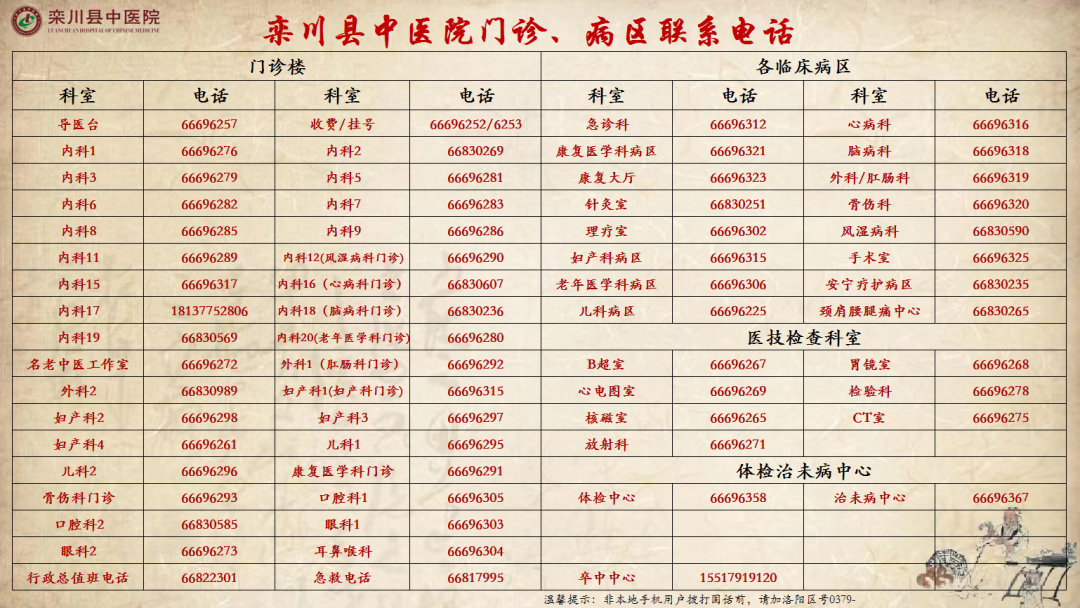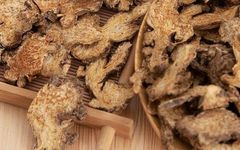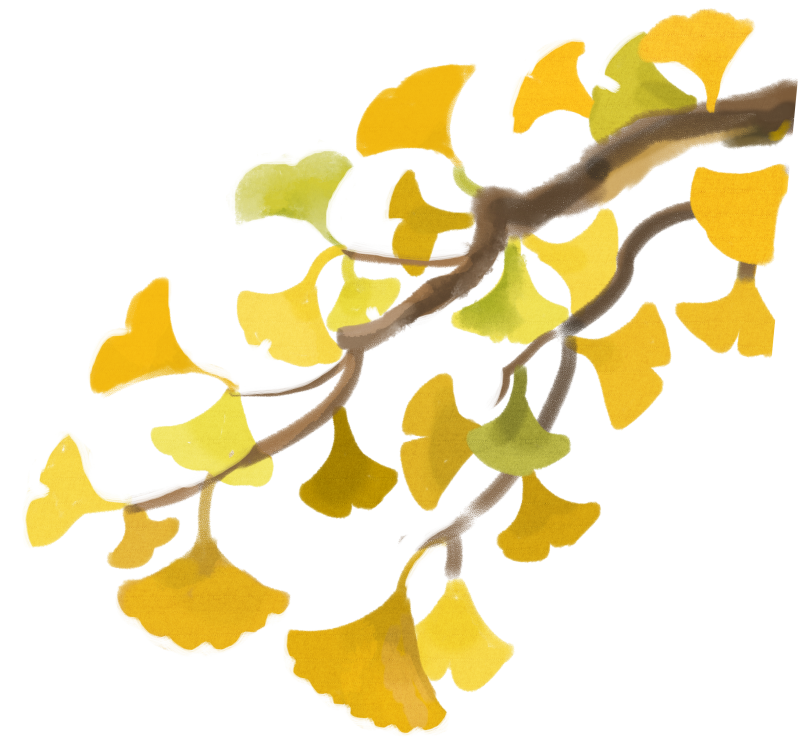
Click the blue text to follow us
Cang Zhu, originally named Zhu, is first recorded in the “Shennong Bencao Jing” (Shennong’s Classic of Materia Medica) and classified as a superior herb. In Zhang Zhongjing’s “Shanghan Lun” (Treatise on Cold Damage), Bai Zhu (White Atractylodes) is used, while Tao Hongjing in the “Mingyi Bielu” (Record of Famous Physicians) distinguishes between Cang Zhu and Bai Zhu. The TCM herb Cang Zhu is prepared from the rhizomes of plants such as Atractylodes lancea and Atractylodes macrocephala, which belong to the Asteraceae family.
Cang Zhu
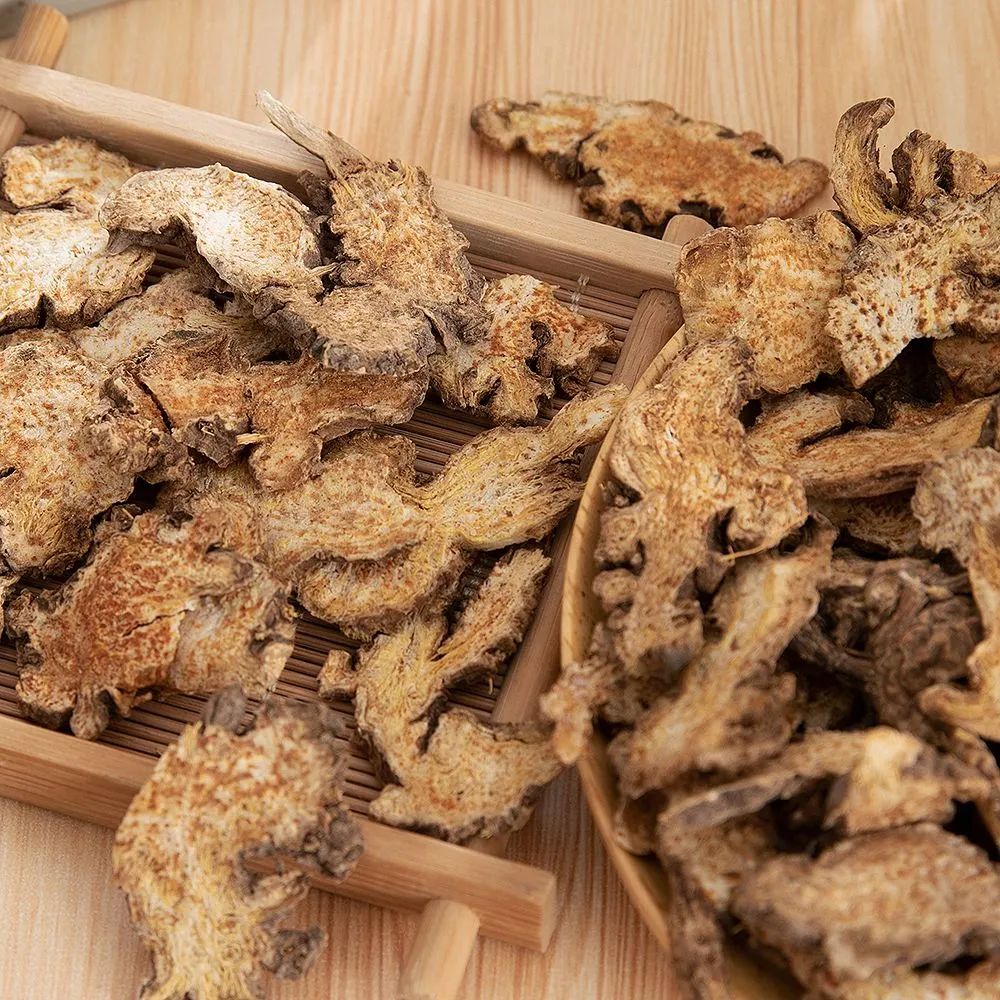
1
Source
The dried rhizomes of the Asteraceae plants Atractylodes lancea or Atractylodes macrocephala.
2
Alias
Chi Zhu, Qiang Tou Cai, etc.
3
Plant Morphology
A perennial herb, 30-80 cm tall. The rhizome is horizontal, nodular, and thick with irregular shapes. The stem is erect and woody at the base. The leaves are alternate, leathery, and the upper leaves are generally undivided, without petioles, ovate-lanceolate to elliptical, with spiny serrations on the edges. The lower leaves are often 3-5 deeply lobed or partially lobed, with the central lobe larger, round or ovate, and the lateral lobes smaller, with or without petioles. The capitulum is terminal, with one whorl of leaf-like bracts, deeply lobed and spiny; the involucre has 6-8 layers, ovate to lanceolate; the flowers are numerous, bisexual, or unisexual and dioecious; all are tubular flowers with many feathery long pappus, and the corolla is white; the bisexual flowers have 5 stamens, and the ovary is densely covered with white soft hairs; the unisexual flowers are generally female with 5 degenerated stamens. The achene is covered with white soft hairs, and the pappus is about 0.8 cm long. The flowering period is from August to October, and the fruiting period is from September to October.
4
Distribution
Mainly produced in Jiangsu, Henan, Hebei, Shanxi, and Shaanxi, with the best quality coming from the Maoshan area in Jiangsu. It often grows in shrublands on hillsides.
5
Harvesting and Processing
Harvested in spring and autumn, cleaned of soil, dried, and the fibrous roots are removed.
6
Characteristics of the Medicinal Material
Atractylodes lancea: Irregularly bead-like or nodular cylindrical, slightly curved, occasionally branched, 3-10 cm long, and 1-2 cm in diameter. The surface is gray-brown, with wrinkles, transverse grooves, and residual fibrous roots, with the top having stem scars or remnants of the stem base. The texture is solid, with a cross-section that is yellow-white or gray-white, scattered with numerous orange-yellow or reddish-brown oil chambers, and if exposed for a while, can yield white needle-like crystals. The aroma is distinctive, with a slightly sweet, spicy, and bitter taste.
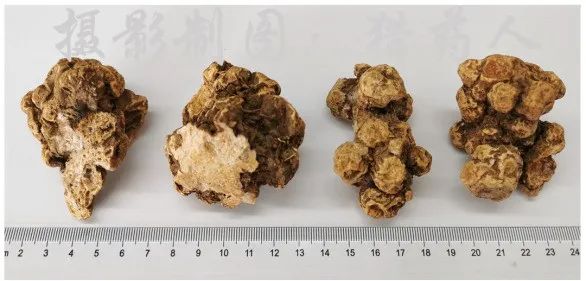
Atractylodes macrocephala: Appears in lump-like or nodular cylindrical shapes, 4-9 cm long and 1-4 cm in diameter. The surface is black-brown, and when the outer skin is removed, it is yellow-brown. The texture is relatively loose, with a cross-section scattered with yellow-brown oil chambers. The aroma is milder, with a spicy and bitter taste.
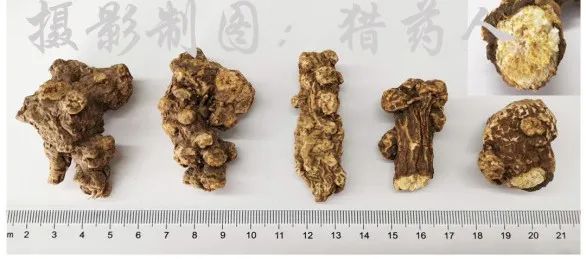
7
Properties and Channels
Warm in nature, with a spicy and bitter taste. It enters the Spleen (Pi) channel, Stomach (Wei) channel, and Liver (Gan) channel.
8
Functions and Indications
Dries dampness, strengthens the Spleen, dispels wind and cold, and improves vision. It belongs to the category of dampness-transforming herbs. It is used to treat abdominal distension, diarrhea, edema, beriberi, rheumatic pain, wind-cold common cold, and night blindness.
9
Clinical Applications
The dosage is 3-10 grams, decocted in water for oral administration.
10
Pharmacological Research
Anti-gastritis, anti-gastric ulcer; regulates gastrointestinal motility; protects the liver from damage; anti-hypoxia; has a blocking effect on nicotinic receptors. The decoction can counteract experimental gastritis and gastric ulcers, significantly inhibiting gastric juice volume, acidity, and pepsin activity. Serum ulcers are caused by ischemia and circulatory disorders of the gastric mucosa leading to tissue necrosis, and Cang Zhu has a significant effect on this. It also has hepatoprotective, choleretic, and anti-hypoxia pharmacological effects.11
Chemical Composition
This product contains atractylon, 2-alkene, atractyloside, patchoulene, elemene, acetyl atractylon, and dehydro-wood fragrance ester. It also contains volatile oils, with the main components being atractylon ketone, atractylon alkyne, and atractylon spiron.
12
Contraindications
Should not be taken in excess; avoid taking with sour foods; contraindicated for pregnant women.
13
Classical Texts
1. “Shennong Bencao Jing”: “Used for decoction. Long-term use can lighten the body, prolong life, and prevent hunger.”2. “Yinshan Zhengyao”: “Taking Cang Zhu: According to ‘Baopuzi’, a man from Nanyang, during a time of chaos, fled to Hushan, hungry and distressed, and someone taught him to eat Zhu, thus he was no longer hungry. After several years, he returned home, looking younger and stronger.”3. “Shijian Bencao”: “Cang Zhu wine: Treats various kinds of rheumatic sores. Heavy Hong Kong foot. Use 30 jin of Cang Zhu, wash and crush. Soak in 3 dan of flowing water for twenty days. Remove the stems. Use the juice to soak the flour. Brew like home-brewed wine. When the wine is ready, drink as desired.”

—Stories of Chinese Medicine—
Xu Xueshi is a respectful title for Xu Shuwei, a renowned physician of the Song Dynasty. It is said that in his youth, Shuwei was exceptionally diligent, studying until late at night before going to bed. Xu Xueshi had a habit of drinking before sleep, perhaps taking the folk saying “A sip of wine before bed can extend life to ninety-nine” to heart! Years later, he often felt gurgling in his stomach, pain in his side, reduced appetite, and would vomit some bitter and sour gastric juice every ten days or so. In summer, his left side would not sweat, while his right side would. What kind of strange illness was this? Xu Shuwei fell into deep thought and sought treatment everywhere. However, despite consulting many famous doctors, he found no relief, which caused him great distress. Therefore, Xu Xueshi abandoned the belief that “a doctor cannot treat himself” and began to save himself. He carefully analyzed and studied his condition, believing that his illness was mainly caused by “dampness obstructing the stomach.” Thus, he followed his academic principle of “using precise medicine” and selected Cang Zhu as the main herb, using 1 jin of Cang Zhu powder, 15 jujubes, and half a liang of raw sesame oil to make small pills, insisting on taking 50 pills daily. He gradually increased the dosage, taking 100-200 pills daily. After several months of medication, his strange illness gradually improved until he was cured.
Why did a single herb, Cang Zhu, have such efficacy and a unique therapeutic effect on Xu Shuwei’s strange illness? It turns out that Xu Shuwei had a fondness for drinking, which harmed his Spleen and Stomach. When the Spleen is deficient and fails to transport, dampness accumulates, leading to “dampness obstructing the stomach” due to the interrelationship between the Spleen and Stomach, resulting in symptoms such as gurgling in the stomach, lack of sweating on the left side in summer, and vomiting gastric juice. The Spleen belongs to the Earth element, which prefers warmth and fragrant aromas. Cang Zhu has a fragrant aroma, is spicy, warm, and bitter, and enters the Spleen and Stomach channels. The medicinal properties align perfectly. Cang Zhu is an aromatic herb that effectively awakens the Spleen and transforms dampness; dampness is associated with Yin energy, which can be transformed with warmth. Xu Shuwei accurately diagnosed his condition and selected the right herb, achieving remarkable results with just one herb. It is also important to recognize that Xu’s insistence on long-term medication and gradually increasing the dosage was a thoughtful approach. He understood that dampness is sticky and stagnant, making it difficult to eliminate quickly. Only by adhering to long-term medication and gradually increasing the dosage could he accumulate the medicinal power in his body and ultimately overcome the dampness.
